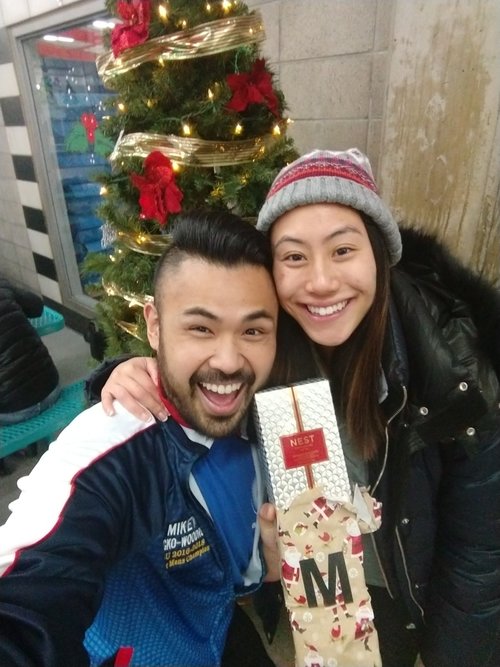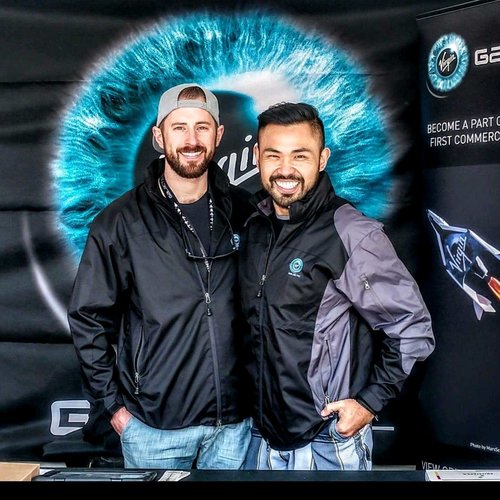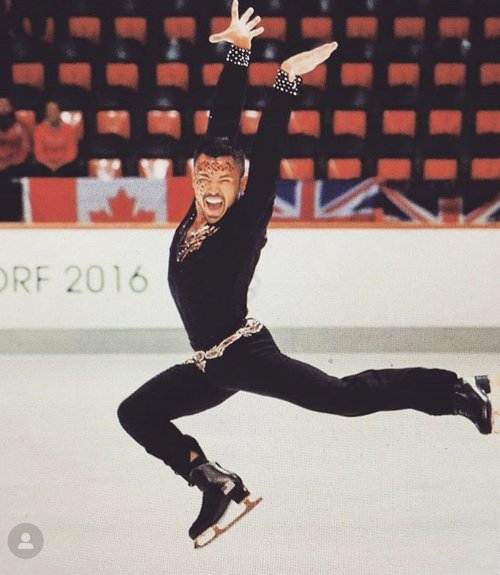In July 2018, a video of Virgin America’s “Dancing Flight Attendant” went viral, boasting over 300,000 views on YouTube alone. Who is the man behind the dance, you may ask?
His name is Mikey Tongko-Burry, a flight attendant of Virgin America Airlines (now Alaska Airlines) since 2011. While his claim-to-fame was the viral video, Mikey is a man of many talents, beyond his ability to put a smile on the face of his passengers. A rhythmic gymnast, singer, actor, cheerleader, and competitive adult figure-skater, “performer” does not even begin to describe Mikey, whose charisma and stage presence turns heads, every time he walks into a room.
Born in the Philippines, Mikey began rhythmic gymnastics at the age of 5. Rhythmic gymnastics, a form of gymnastics that combines elements of dance, contortion, and manipulation of hand apparatus, is historically performed only by females. This, however, did not stop Mikey from doing what he loved. When he was 6 years-old, he and his family moved to Southern California, where he continued rhythmic at the Los Angeles School of Gymnastics, reaching level 7 in the sport. When Mikey was 13 years-old, USA Gymnastics forced him to quit the sport, as it was something “only females did”. For a federation to go up against a young boy and force him to quit his sport because of his gender is not only cruel, it is a blatant act of discrimination, and would certainly not be tolerated in today’s society. But it was a different time, then. Mikey describes this experience as “having my heart and soul and part of my being ripped out of me”. Rhythmic was his first love. It is a sport that allows its participants to express themselves and interpret music. While his career was tragically cut short, Mikey credits rhythmic gymnastics for training him as a performance artist and opening his heart to the beauty of creative expression in front of an audience.
After rhythmic was over, Mikey continued to grow as a performer through cheerleading, theater, singing, and dancing. He graduated university with a degree in music education. In 2009, he moved to South Korea to teach English to Korean students. It was in Korea that Mikey fell in love with figure skating.
In the 2010 Vancouver Olympics, South Korean figure skater Yuna Kim captivated audiences worldwide through her combination of strong technical ability, delicate musical interpretation, and effortless grace and artistry. She was the Olympic gold medalist that year and became an international sensation. Kim’s home country was crazed with pride, and figure skating— already a popular sport in South Korea— received more media coverage and publicity than ever.
Mikey, who was living in South Korea at the time, got caught up in the figure skating frenzy. At 25, he was inspired to start the sport. There was a skating rink 10 miles away from his apartment, where he began training. His rhythmic gymnastics background helped him improve rapidly in his skating. Within 6 months, Mikey had broken into the adult figure skating competitive circuit and won first place at his very first skating competition. He fondly recalls the widespread support he received from the Korean audience, who, following his performance, threw chocolates onto the ice as a gesture of their appreciation. There were so many chocolates that Mikey’s then-coach, Ji-Suk Park, had to get on the ice to help Mikey pick all of them up!
Mikey’s successes continued to grow from there. In addition to winning many local competitions, Mikey represented the US in 3 international competitions, and won all three! He currently skates in the adult silver 1 division.
In 2011, Mikey moved back to the US. Within one month, he landed a job as a flight attendant for Virgin America. Mikey says that he never saw himself working for any other airline besides Virgin. “The airline is cutting edge, the planes look like nightclubs, and the uniforms are sexy.”
When asked how he manages to balance his work as a flight attendant with competitive figure skating, Mikey says, “Working as a flight attendant allows for a very flexible schedule. During the first few years, when you’re on ‘reserve’, it’s really busy, because you’re on call all the time. But after that, you have the freedom to choose which days you want to fly.”
Mikey’s weekly schedule is as follows: Friday, Saturday, Sunday, and Monday are spent flying. Tuesday, Wednesday, Thursday, and Friday mornings are spent at his home rink in Oakland, CA, where he trains 2 to 2.5 hours a day and coaches 4 to 5 group lessons a week. He also takes lessons from his coach, Michelle Hong, who has been his coach since 2016. “I honestly don’t know what I would do without [Michelle]. She’s my best friend.”
Even when traveling for work, Mikey is able to squeeze in some ice time. “I fly out to a lot of cities with ice rinks: Dallas, LA, Seattle, New York, Florida… After we land at night, I head to the hotel, go to sleep, then wake up early the next morning to go to the rink for practice.”
It may take some strategic planning, but Mikey makes it work. When asked what he loves most about competitive adult figure skating, Mikey replies, “I love the camaraderie between fellow skaters. Every competition is like a huge family reunion. We all want to see each other succeed, and there’s a tremendous amount of love and support within the adult skating community.” The dynamic of the competitive adult figure skating circuit, comprised of skaters who began skating later in life, is very different from that of the standard competitive circuit, in which young figure skaters all vye for a shot at the Olympics. “[In the standard circuit], everyone is super focused on making the Olympics. When you’re an adult, you have different goals.”
As a veteran competitor and performer, Mikey has developed a pre-competition ritual that gets him into the optimal headspace for peak performance. When he arrives at the competition venue, he begins with ballet barre exercises, then proceeds to sit in his splits, 2-3 minutes on each side. All the while, he will have headphones on, listening to his program music. Deep breathing and visualization help him get in the zone. After he is finished with off-ice warm up, he will head into the arena, where he visualizes his program as it will appear on the ice. Once this step of the process is over, he heads backstage, where joking around and laughing with his skating friends calms his nerves. It is no surprise that Mikey, a people-person to the core, finds comfort in interacting with others.
Each competition is preceded by a 5-minute warm up session, where skaters are given the chance to feel the ice and practice their jumps before the competition begins. The minute Mikey steps onto the ice, he is in performance mode. Even during warmup, he makes sure to address the judges and audience and put forth his performance persona. “The cameras are all around you, and warmup gets broadcasted on television. There are people from home watching you.”
After warm up is over, Mikey is often exhausted and drenched in sweat. His exhaustion actually calms him down, such that, when it is time for him to perform, he is cool and composed.
When asked what goes through his head if he makes a mistake mid-program, Mikey replies, “I remind myself that there are 7 more elements in the program that need to be executed. If something doesn’t work out, then you gotta just move on. It is in these moments especially that I rely most heavily on muscle memory.” Indeed, there is a saying common among athletes: trust your training. Athletes, and performers in general, must be confident in their practice so that, should something not go as planned during the live performance, they can continue their performance without having a total meltdown.
Mikey, laughing, admits, “The last time I fell in competition was in 2014.” What’s interesting is that Mikey often has “horrible practices” at competition, but is able to deliver “great performances”.
A big reason why Mikey places so well in competition is because his programs, which he choreographs himself, are both unique and deeply emotional. In adult skating competitions, competitors perform two programs: the technical program and the artistic program. In the US, the artistic program is comprised of two subcategories that differ in musical genre: a “dramatic” program, intended to leave the audience with chills, and a “light-hearted” program that is more of a fun crowd pleaser. The US also allows adult skaters to use props in their programs. So of course, Mikey returns to his roots as a rhythmic gymnast and incorporates the hoop and ribbon, his two favorite apparatuses, to his skating programs. The end result is a masterfully put-together product that “the audience is not used to”. Mikey fondly recalls one competition where, in the middle of his artistic program, he threw his hoop up in the air right in front of the judges’ panel, and skillfully caught the hoop around his neck. According to his friend, one of the judges began clapping with delight, after the element was executed! To this date, Mikey’s favorite program is his 2014 ribbon artistic program, skated to “Carmina Burana”, an intense, hair-raising operatic piece. He was inspired by Ukrainian rhythmic gymnastics legend, Anna Bessonova, who performed her 2009 ribbon routine to the same music.
Mikey’s natural stage presence and ability to feel and express the music is what sets him apart from many other adult skaters. As a coach, he urges his students to “blossom into artists”. When asked about his coaching method and philosophy, Mikey says, “I am strict with my students because I want them to be fantastic. But I coach with a loving approach. If [my student] has a good skate [at competition], I will give them a hug. I they have a bad skate, I will also give them a hug.” Mikey’s stern but loving coaching style is both healthy and, research has shown, more conducive to learning than abusive coaching where punishment and fear are wielded as weapons to demand results. When asked about his thoughts on abusive coaching, Mikey says, “My students can’t learn if they are terrified of their coach.” While he does push his students to overcome mental limitations, like fear of falling, he also wants skating to be “fun” for his students, rather than “something stressful and frustrating”.
Many young skaters find it difficult to reconcile having fun in the sport with the constant pressure placed on their tiny shoulders to perform to perfection. Mikey says that, while skating is an intense sport, it is important to maintain the “love and longevity” of the sport. Many young skaters who push themselves past their physical and mental limits are likely to get injured or burn out prematurely.
For many young skaters, figure skating constitutes their entire identity and consumes their lives. When asked what he thought of this blind devotion to the sport, Mikey says, “It is true that to succeed in figure skating requires a large degree of commitment. But I believe that it’s so important to have an education to fall back on, in case skating doesn’t work out.” As for the role figure skating plays in Mikey’s own life, Mikey replies, “Skating to me is another addition to my life. While skating is a big part of my life, it is not my entire being. When I first started, the sport was all-consuming. Now, my priorities have shifted. My fiance and I are planning our wedding. We’re buying a house. And eventually, we’d want children.”
In addition to lack of life balance, many young competitive skaters must cope with negative body image. Body image issues and eating disorders are common in aesthetic sports like rhythmic gymnastics and figure skating, where emphasis is placed heavily on presentation and outward appearance. Mikey concedes that body image struggles are always going to exist to some extent, in these aesthetic, performance-based sports. In figure skating, it’s not just about the way you look; it’s about how you feel when throwing yourself into the air, rotating your body, and landing soundly on your thin blade. If you gain 20 lbs, your jumps will definitely feel a lot different than before. Mikey states that one major difference between the standard and adult competitive circuit is that, in adult skating, “it doesn’t really matter how you look. As long as you are confident, selling the program, and feeling good while skating, that’s all that matters.” He adds, “It is hard to constantly fight the scale when you’re an adult. You have day jobs, and sometimes life gets in the way. If I have to attend a work dinner, I’m not going to starve myself because of my skating.”
While work dinners and skating life may not be compatible, Mikey has been able to utilize his performance skills garnered through years as a skater in his job as a flight attendant. In 2013, Virgin America Airlines made a music video to go along with their safety demonstrations. “The marketing team told us, if there’s anyone who wants to perform for the passengers during these demos, feel free!” Mikey, being Mikey, jumped at this opportunity. “I first came up with the choreography for the dance while running on the treadmill. I pretended the treadmill was the aisle of the plane!” There were certain moments in the music where Mikey was able to show off his flexibility. “In the ‘Ding’ part of the video, my leg goes up. And on the lyrics ‘base of seat’, I do the splits.” When asked what inspired him to create this entertaining safety demo dance for passengers, Mikey says, “Travelling can be a stressful experience for passengers. I want to make travelling fun for them, instead of stressful.” The video of the “Dancing Flight Attendant” went viral three different times: once at the end of 2013, another time in spring of 2014, and most recently, in July of 2018, right before Virgin America was bought by Alaska Airlines. The public’s response to the video was overwhelmingly positive. “He’s really a great and motivated flight attendant”, read one YouTube comment. “This guy needs a raise”, said another.
When asked how different his life was after the video went viral, Mikey replies, “A lot of people recognize me. They’ll ask for pictures and autographs.” He quickly adds, “I am still the same person. This is just another cool addition to my life; I don’t get a big head because of it.” It is remarkable how grounded and down-to-earth Mikey remains, after the video. He was featured on multiple news outlets worldwide, like BBC and Headline News, and was even invited to meet the the Virgin Group founder, Richard Branson, which Mikey states was a “cool” experience.
I became friends with Mikey back when I was still a competitive rhythmic gymnast, long before his celebrity. He and I took contortion lessons from the same teacher to improve our flexibility in our respective sports. Mikey inspires me in so many ways. His larger-than-life personality, radiant smile, natural performance ability, and huge heart are just some of the many things I love about him. As a gymnast, I was trained not to laugh or have fun during practice. Even at contortion class, I seemed cold and standoffish to others, because I did not speak to anyone. Mikey was the first person then to make me crack a smile, during class. And it is that small act of kindness that I will always remember Mikey by.
FUN FACTS
Favorite color(s): Blue
Favorite movie(s): “10 Things I Hate About You”; “Center Stage”; “Bring It On”
Kind of music you listen to: Top 40 pop; Backstreet Boys, Christina Aguilera, Britney Spears (easy to dance to)
Hobbies/passions outside of skating and rhythmic: Cooking and baking; watching Food Network; singing and dancing; watching beauty pageants (huge part of Filipino culture)
What languages do you speak besides English? Tagalog; high school Spanish; some Korean; some Russian (from rhythmic gymnastics and skating)
What are some words you’d use to describe yourself?
- Optimistic
- Energetic
- Bubbly







